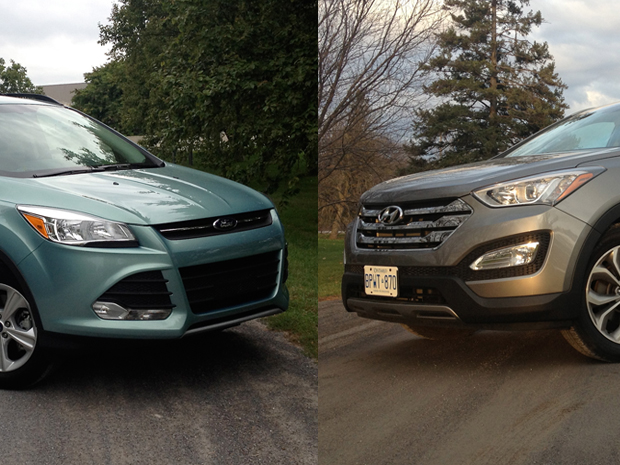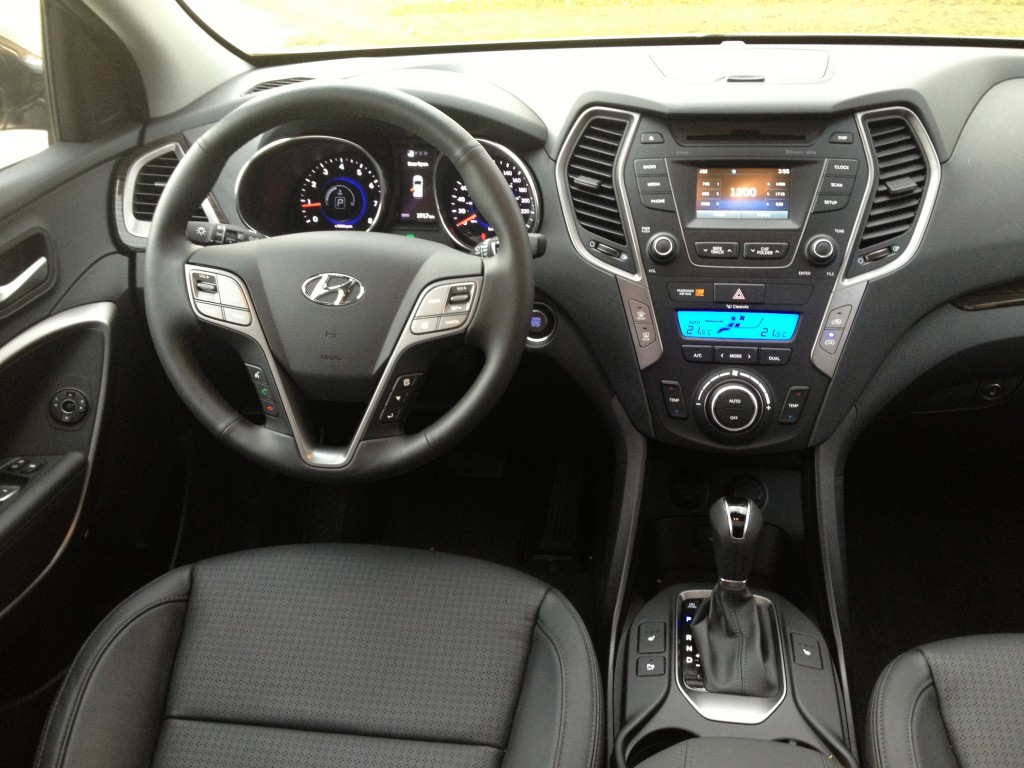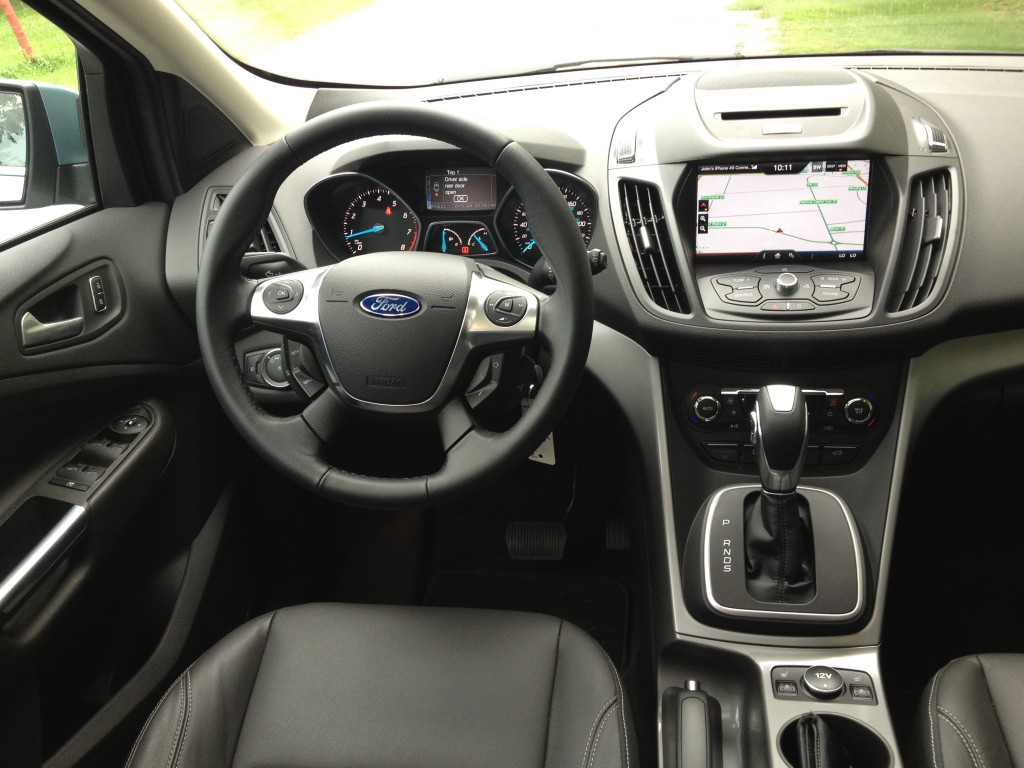Comparo: 2013 Ford Escape versus Hyundai Santa Fe Sport
Story and photos by John LeBlanc
Station wagons aren’t dead. They’ve just been reincarnated into crossovers, essentially a taller, beefed-up version of what our parents were chauffeured around in when they were kids.
Two of the biggest sellers in today’s compact crossover segment are all-new for 2013: the Ford Escape and the Hyundai Santa Fe. Like most Fords these days, the new Escape was designed in Europe. It’s roomier, more fuel efficient and drives and handles better than the decade-old original. Although the model the new Santa Fe is replacing is more modern than the outgoing Ford, the 2013 version is an improvement in almost every area as well.
So which one is the better station wag-, er, crossover?

FIRST PLACE: 2013 Hyundai Santa Fe Sport SE
The new, third-generation 2013 Santa Fe is a thorough redo of a model that’s been on sale since 2007. And while the previous iteration was sold primarily on its low price, the new model promises higher levels of refinement, better fuel economy, more sophisticated ride and handling and oodles of luxury features.
A longer-wheelbase, seven-passenger Santa Fe with a V6 shows up this spring. For now, though, the two-row, five-passenger Santa Fe Sport starts at $25,349 with a 190-horsepower 2.5-litre four-cylinder engine matched to a six-speed automatic transmission. Equal to our well-equipped Escape SEL tester is the Santa Fe Sport SE model with a turbocharged 2.0L four. At $35,299, it matches the Ford with all-wheel-drive and upscale features, then adds extras like heated rear seats, a heated steering wheel, rear dual-zone climate control and 19-inch rubber.
The Hyundai also betters the Ford on interior space and fit and finish. While a few of our Escape’s cockpit pieces didn’t align perfectly and felt cheap, the Santa Fe’s interior felt robust and looked more upscale. Neither of these crossovers’ infotainment systems are class leading, though. The Santa Fe’s central digital screen is too tiny and far to reach, and its infotainment buttons are fiddly. However, as a utility vehicle, the Hyundai offers more rear legroom and cargo room aft of its second-row seating (2,025 litres versus 1,928 in the Ford) and can also tow more than the Escape (1,590 kilograms versus 680).
Details aside, perhaps the strongest impression the new Santa Fe makes is its swift and easy-going nature on the road. Its cabin is serenely quiet and solid-feeling, with a supple ride that sops up potholes like a biscuit mops up gravy. The combination of less weight (the Santa Fe weighs 91 kilograms less than the Escape) and more oomph (Hyundai’s turbo four offers 27 more horsepower and 19 more pound-feet of torque than the Ford turbo four’s 237 hp and 250 lb-ft ratings) means it’s no surprise the Santa Fe is 0.5 seconds quicker from zero to 100 km/h than the Escape’s 7.2 seconds time.
For crossover buyers looking for value, luxury features and a comfortable ride, Hyundai’s new Santa Fe Sport SE is a winner.

SECOND PLACE: 2013 Ford Escape SEL AWD
Comparing the outgoing 2012 Escape to the new 2013 version is like comparing a slingshot to the recently retired U.S. Space Shuttle. Faster, more economical, roomier, more stylish and better to drive, the new Escape is right near the top of today’s very combative compact crossover class.
While front-drive Escapes (with a 168-hp naturally aspirated four-cylinder and a six-speed automatic transmission) start at $21,499, our better-equipped SEL started at $31,599 plus $6,150 worth of options, highlighted by AWD, heated leather seats and outside mirrors, upgraded infotainment, navigation, a huge sunroof and a power liftgate — essentially matching our less-expensive Santa Fe tester.
Opt for the Escape in SEL trim, and you get a turbocharged 2.0L four-cylinder. As mentioned, it’s not as powerful as the Santa Fe Sport’s blown mill. But at least it gets better Transport Canada fuel economy estimates: 9.8 L/100 km in the city and 6.9 on the highway (whereas the Hyundai scores 11.0 and 8.4, respectively).
We already know the Hyundai offers a roomier and more premium-feeling interior, and a quieter and more comfortable ride. The Santa Fe Sport SE can tow more than twice as much as the Escape SEL AWD, but the one area the Ford spanks the Hyundai is from behind the driver’s seat.
If you want a crossover that thinks it’s a sports compact, buy an Escape. For the most part, the Ford crossover drives like a heavier, taller version of the fine-handling Focus compact it’s based upon.
Despite a taller centre of gravity than a Focus, the Escape turns into corners readily, with a rear-end that follows right along. Like the Hyundai, the Ford’s steering could communicate more to the driver about what’s happening down at road level. But the Escape’s steering delivers more feel off-centre than the Hyundai does, and allows the driver to be accurate in placing the vehicle when cornering.








![[del.icio.us]](https://www.straight-six.com/wp-content/plugins/bookmarkify/delicious.png)
![[Digg]](https://www.straight-six.com/wp-content/plugins/bookmarkify/digg.png)
![[Facebook]](https://www.straight-six.com/wp-content/plugins/bookmarkify/facebook.png)
![[Google]](https://www.straight-six.com/wp-content/plugins/bookmarkify/google.png)
![[Reddit]](https://www.straight-six.com/wp-content/plugins/bookmarkify/reddit.png)
![[StumbleUpon]](https://www.straight-six.com/wp-content/plugins/bookmarkify/stumbleupon.png)
![[Twitter]](https://www.straight-six.com/wp-content/plugins/bookmarkify/twitter.png)
![[Email]](https://www.straight-six.com/wp-content/plugins/bookmarkify/email.png)